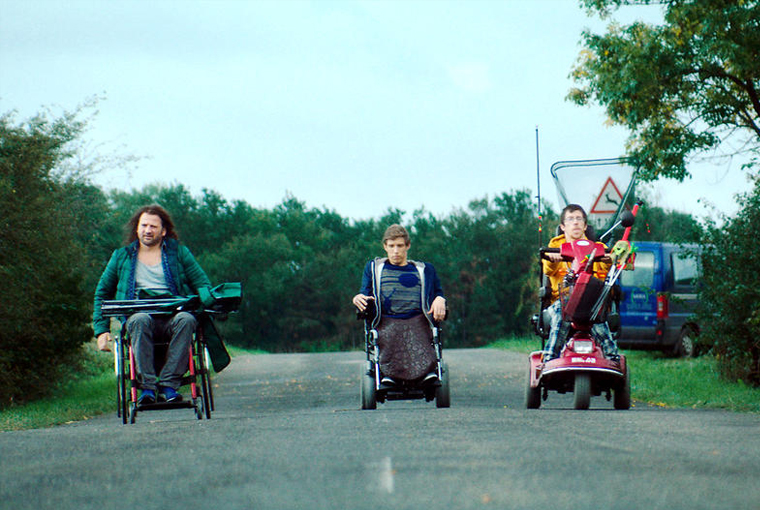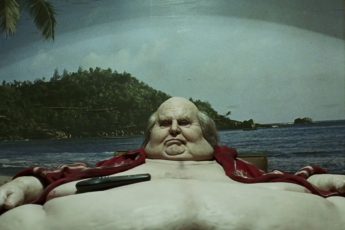A Romp through Gangster Paraplegia
Attila Till’s Kills on Wheels (Tiszta Szívvel, 2016)
Vol. 67 (September 2016) by Patricia Bass
Attila Till’s Kills on Wheels opens with what looks like an assassination amongst jail inmates. Grizzled middle-aged men in wheelchairs are playing cards and socializing in an institutional lounge. In a split second, the tense ambiance is catalyzed – one of them makes a quick turn, covering the mouth of the man next to him with a cloth and brutally knocking him to the floor. The room erupts in violence – tables are overturned, fights break out in all corners, and able-bodied attendants hurriedly appear to break things up.
Janos Rupaszov (Swabolcs Thuroczy), a built man in his forties with an unkempt ponytail, is the paraplegic hit-man who set this violence in motion. We next see him doing pull-ups. But not the classic pull-ups of any protagonist’s training. Janos has tied his arms, legs and torso to his wheelchair and hoists his body with his mobile prosthesis into the air each time he raises his head and shoulders above the bar. The attempted assassination of the previous scene, combined with this feat of strength introduces Janos as a ruthless and nearly superhuman antihero.
The film is a classic action-comedy. A depressed and hardened firefighter-turned-hit-man, Janos, reluctantly takes on two earnest and bumbling teens as accomplices, inadvertently becoming a father figure for them along the way. The hit-man’s boss, a slimy and treacherous Yugoslavian crime lord, ultimately turns on his hire, creating the conditions for one last – and particularly dangerous – “hit” for Janos and co.
The catch is that Janos and his two protégés are all handicapped. Janos is confined to a wheelchair since a firefighting accident where he lost the use of the lower half of his body. Since then, he has struggled to control his anger and to finally accept the loss of his legs – not to mention the loss of his long-time girlfriend. Zoli (Zoltan Fenyvesi) and Barba (Adam Fekete) are best friends and roommates in a care facility. Zoli has a progressive spinal condition, which gives him frequent, intense back-pain and prevents the use of his legs. Barba has a mild case of cerebral palsy, which manifests itself in a loping gate and tremor. Zoli and Barba are partners in crime long before they meet Janos. They co-create a graphic novel together, for example, which provides the (very hip) visual theme of the credits and transitions throughout the film. They also get into trouble, at one point stealing a fire extinguisher in order to spray it around in the street.
Although the “coming-of-age” of these boys constitutes a strong theme, Kills on Wheels doggedly avoids the saccharine. Sure, Zoli’s single mother (Mónika Balsai) struggles to ask Zoli’s father, who abandoned the family, for the money necessary for his son’s life-saving operation. Yet the film does not dwell on this subplot. Instead, the situation is mobilized to show Zoli’s adolescent desire for independence (fights with his mother, his desire to pay for the surgery himself) and his financial motivation to assist in the “hits”. In Kills on Wheels, the impending doom isn’t illness-related death or disability, as it is in so many other disability-centered films. Instead, it is the possibility of being eaten alive by a crime lord’s posse of attack dogs.
This take on disability was no accident. Director Attila Till systematically watched films featuring handicapped characters from the last ten years in order to create a new work that would feature actual handicapped actors in a new ambiance. First-time actor Zoltan Fenyvesi and experienced dramaturge Adam Fekete do justice to such an ambition, proving that there is no contradiction between physical handicap and solid acting. Both are well-cast for their roles. Fenyvesi, whose dashing good lucks may explain his frequent attendance at Hungarian fashion events, was an Instagram star, motivational speaker, marathon biker, and university student when Till recruited him for the film. In interviews, he claims to have had difficulty acting petulant with Mónika Balsai (who plays his mother) during shooting, but his adolescent angst seems too natural to be faked. His real-life Instagram “selfie” habit and student status also make him the perfect candidate for the role of brooding, rebellious teen Zoli. Fekete uses the acting skills that he normally employs as a member of the TAP Theater Company to play Fenyvesi’s comic foil, Barba.
Zoli and Barba’s comedic duo makes Kills on Wheels a Eastern European black comedy in the style of Serbian director Srdan Dragovic’s Pretty Village, Pretty Flame (1996) or Parade (2011). These films address difficult contemporaneous topics such as the Balkan wars and the tragic violence of the 2010 gay pride parade in Belgrade through slapstick jokes and brutal honesty. Whereas Dragovic, on the one hand, uses goofy stereotypes, sensationalized violence, and slapstick for a scathing critique of ethnic warfare and state-sanctioned homophobic violence, Till’s film mobilizes the same tools to normalize the differently-abled.
The result is a light, but incredibly well-made film. The score by Csaba Kalotas and the soundtrack evoke Nick Cave and a dark, Western-style ambiance. The cinematography often gives the audience a “wheelchair level” point of view, and the editing artfully transforms gouache and pen-and-ink drawings into animations and real-life footage. Able-bodied theater actor Swabolcs Thuroczy is the ideal-type of a bitter yet begrudgingly heroic father figure, a kind of “Hans Solo” of the underworld. Similarly, Dusan Vitanovic, a neurosurgeon in real life, plays the heartless villain to a T, as he mocks Janos for his disability and sets his attack dogs on anything that moves. These characters are so two-dimensional it is nearly laughable, but this aligns with the graphic novel theme. More problematically, an ambitious attempt at a story “twist” in the final scenes falls flat due to a combination of overkill and plot holes. That I leave to the viewer to experience for her or himself, though. The charisma of the actors and the quality of production make for an enjoyable, albeit very “safe”, action-comedy, and what comic book doesn’t include the absurd?




Leave a Comment